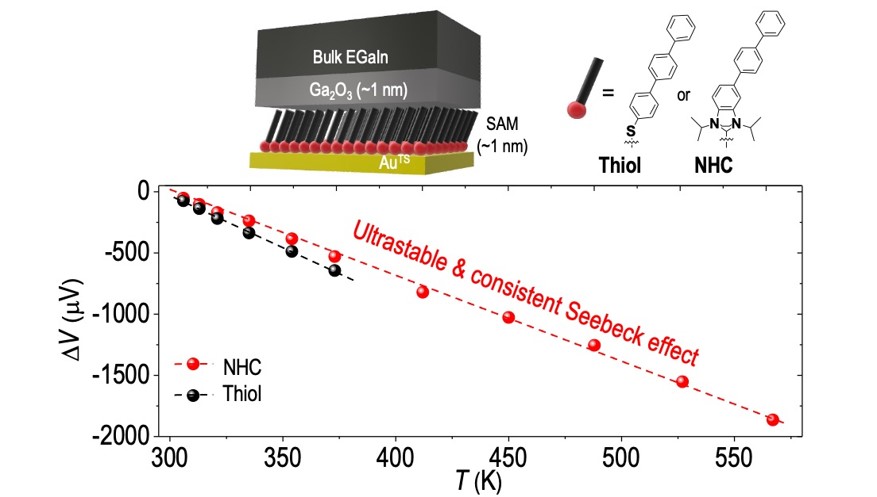Thermopower of Molecular Junction in Harsh Thermal Environments
| author | Hyo Jae Yoon |
|---|---|
| Homepage | https://hyojaeyoon.wixsite.com/omml |
| journal | Nano Letters |
Molecular junctions can be miniaturized devices for heat-to-electricity conversion application, yet these operate only in mild thermal environments (less than 323 K) because thiol, the most widely used anchor moiety for chemisorption of active molecules onto surface of electrode, easily undergoes thermal degradation. N-Heterocyclic carbene (NHC) can be an alternative to traditional thiol anchor for producing ultrastable thermoelectric molecular junctions. Our experiments showed that the NHC-based molecular junctions withstood remarkably high temperatures up to 573 K, exhibiting consistent Seebeck effect and thermovoltage up to approximately |1900 μV|. Our work advances our understanding of molecule–electrode contact in the Seebeck effect, providing a roadmap for constructing robust and efficient organic thermoelectric devices.

https://pubs.acs.org/doi/full/10.1021/acs.nanolett.2c00422
« Prev Li-ion Intercalation, Rectification, and Solid Electrolyte In...
 Li-ion Intercalation, Rectification, and Solid Electrolyte In...
2023.05.08by webmaster2
〈
Li-ion Intercalation, Rectification, and Solid Electrolyte In...
2023.05.08by webmaster2
〈
Microfluidics-Assisted Synthesis of Hierarchical Cu2O Nanocry... Next »
 Microfluidics-Assisted Synthesis of Hierarchical Cu2O Nanocry...
2023.05.08by webmaster2
〉
Microfluidics-Assisted Synthesis of Hierarchical Cu2O Nanocry...
2023.05.08by webmaster2
〉
Articles
- Self-Aggregating Tau Fragments Recapitulate Pathologic Phenotypes and Neurotoxici...
-
 Ultranarrow Mid-infrared Quantum Plasmon Resonance of Self-Doped Silver Selenide ...
Ultranarrow Mid-infrared Quantum Plasmon Resonance of Self-Doped Silver Selenide ...
-
 Molecular Thermoelectricity in EGaIn-Based Molecular Junctions
Molecular Thermoelectricity in EGaIn-Based Molecular Junctions
-
 Perovskite Nanocatalsts Protected by Hermetically Sealing for Highly Bright and S...
Perovskite Nanocatalsts Protected by Hermetically Sealing for Highly Bright and S...
-
 The importance of a charge transfer descriptor for screening potential CO2 reduct...
The importance of a charge transfer descriptor for screening potential CO2 reduct...
-
 Resonant Raman-Active Polymer Dot Barcodes for Multiplex Cell Mapping
Resonant Raman-Active Polymer Dot Barcodes for Multiplex Cell Mapping
-
 Decoding the Roles of Amyloid-β (1-42)'s Key Oligomerization Domains toward Desig...
Decoding the Roles of Amyloid-β (1-42)'s Key Oligomerization Domains toward Desig...
-
 Flattening bent Janus nanodiscs expands lattice parameters
Flattening bent Janus nanodiscs expands lattice parameters
-
 Directing the surface atomic geometry on copper sulfide for enhanced electrochemi...
Directing the surface atomic geometry on copper sulfide for enhanced electrochemi...
-
 High Seebeck Coefficient Achieved by Multinuclear Organometallic Molecular Junctions
High Seebeck Coefficient Achieved by Multinuclear Organometallic Molecular Junctions
-
 Thermopower in Transition from Tunneling to Hopping
Thermopower in Transition from Tunneling to Hopping
-
 An Activity-Based Fluorescent Probe for Imaging Fluctuations of Peroxynitrite (ON...
An Activity-Based Fluorescent Probe for Imaging Fluctuations of Peroxynitrite (ON...
-
 Deep learning for development of organic optoelectronic devices: Efficient prescr...
Deep learning for development of organic optoelectronic devices: Efficient prescr...
-
 Photocatalytic Superoxide Radical Generator that Induces Pytoptosis in Cancer Cells
Photocatalytic Superoxide Radical Generator that Induces Pytoptosis in Cancer Cells
-
 Direct C-H metallation of tetrahydrofuran and application in flow
Direct C-H metallation of tetrahydrofuran and application in flow
-
 Functionalization of Diamine-Appended MOF-Based Adsorbents by Ring Opening of Epo...
Functionalization of Diamine-Appended MOF-Based Adsorbents by Ring Opening of Epo...
-
 High Gravimetric and Volumetric Ammonia Capacities in Robust Metal-Organic Framew...
High Gravimetric and Volumetric Ammonia Capacities in Robust Metal-Organic Framew...
-
 Li-ion Intercalation, Rectification, and Solid Electrolyte Interphase in Molecula...
Li-ion Intercalation, Rectification, and Solid Electrolyte Interphase in Molecula...
-
 Thermopower of Molecular Junction in Harsh Thermal Environments
Thermopower of Molecular Junction in Harsh Thermal Environments
-
 Microfluidics-Assisted Synthesis of Hierarchical Cu2O Nanocrystal as C2-Selective...
Microfluidics-Assisted Synthesis of Hierarchical Cu2O Nanocrystal as C2-Selective...
Designed by sketchbooks.co.kr / sketchbook5 board skin